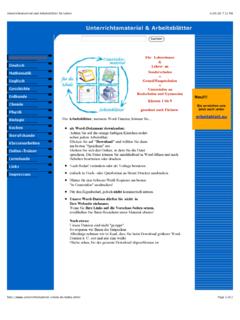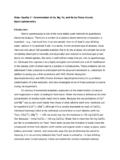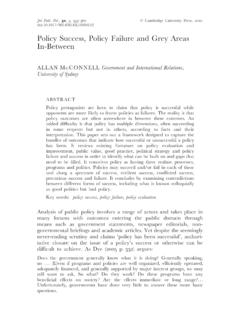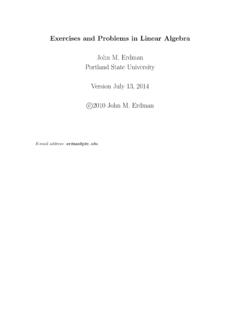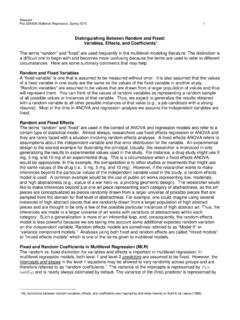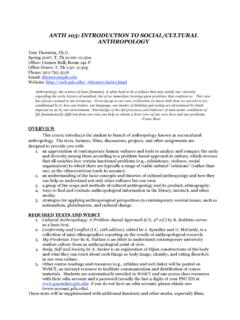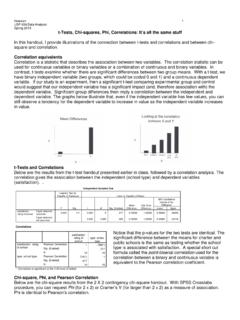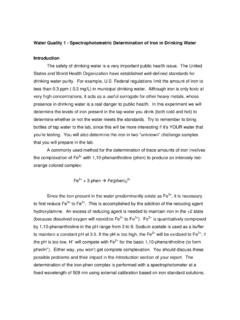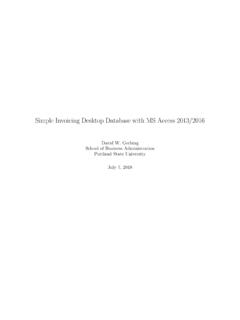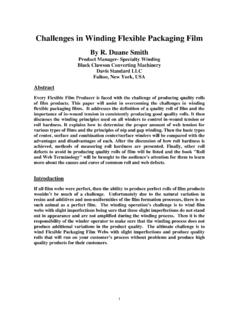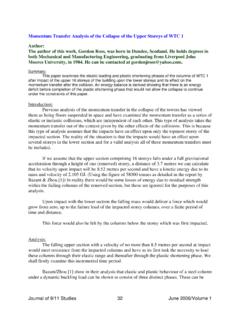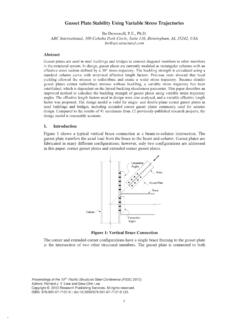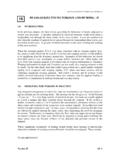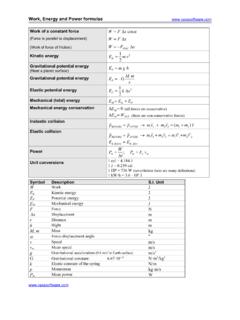Transcription of Raman Spectroscopy Basics - Portland State …
1 Page 1 of 5 Raman the FutureIntroductionRaman Spectroscopy is a spectroscopic technique based on inelastic scattering of monochromatic light, usually from alaser source. inelastic scattering means that the frequency of photons in monochromatic light changes upon interactionwith a sample. Photons of the laser light are absorbed by the sample and then reemitted. Frequency of the reemittedphotons is shifted up or down in comparison with original monochromatic frequency, which is called the Raman shift provides information about vibrational, rotational and other low frequency transitions in molecules. Ramanspectroscopy can be used to study solid, liquid and gaseous Origins of RamanThe Raman effect is based on molecular deformations in electric field E determined by molecular polarizability.
2 The laserbeam can be considered as an oscillating electromagnetic wave with electrical vector E. Upon interaction with the sampleit induces electric dipole moment P = E which deforms molecules. Because of periodical deformation, molecules startvibrating with characteristic frequency of vibration is called a nuclear displacement. In other words, monochromatic laser light with frequency 0excites molecules and transforms them into oscillating dipoles. Such oscillating dipoles emit light of three differentfrequencies ( ) when:1. A molecule with no Raman -active modes absorbs a photon with the frequency 0. The excited molecule returns backto the same basic vibrational State and emits light with the same frequency 0as an excitation source. This type ifinteraction is called an elastic Rayleigh A photon with frequency 0is absorbed by Raman -active molecule which at the time of interaction is in the basicvibrational State .
3 Part of the photon s energy is transferred to the Raman -active mode with frequency mand the resultingfrequency of scattered light is reduced to 0- m. This Raman frequency is called Stokes frequency, or just Stokes .3. A photon with frequency 0is absorbed by a Raman -active molecule, which, at the time of interaction, is already in theexcited vibrational State . Excessive energy of excited Ramanactive mode is released, molecule returns to the basicvibrational State and the resulting frequency of scattered light goes up to 0+ m. This Raman frequency is called Anti-Stokes frequency, or just Anti-Stokes . Raman Spectroscopy BasicsFigure 1: Raman transitional schemespage 2 of 5 Raman the FutureAbout of all incident photons in spontaneous Raman undergo elastic Rayleigh scattering. This type of signal isuseless for practical purposes of molecular characterization.
4 Only about of the incident light produces inelasticRaman signal with frequencies 0 m. Spontaneous Raman scattering is very weak and special measures should be takento distinguish it from the predominant Rayleigh scattering. Instruments such as notch filters, tunable filters, laser stopapertures, double and triple spectrometric systems are used to reduce Rayleigh scattering and obtain high-quality InstrumentationA Raman system typically consists of four major components:1. Excitation source (Laser).2. Sample illumination system and light collection Wavelength selector (Filter or Spectrophotometer).4. Detector (Photodiode array, CCD or PMT).A sample is normally illuminated with a laser beam in the ultraviolet (UV), visible (Vis) or near infrared (NIR) range. Scatteredlight is collected with a lens and is sent through interference filter or spectrophotometer to obtain Raman spectrum of spontaneous Raman scattering is very weak the main difficulty of Raman Spectroscopy is separating it from theintense Rayleigh scattering.
5 More precisely, the major problem here is not the Rayleigh scattering itself, but the fact thatthe intensity of stray light from the Rayleigh scattering may greatly exceed the intensity of the useful Raman signal in theclose proximity to the laser wavelength. In many cases the problem is resolved by simply cutting off the spectral range closeto the laser line where the stray light has the most prominent effect. People use commercially available interference(notch) filters which cut-off spectral range of 80-120 cm-1from the laser line. This method is efficient in stray light eliminationbut it does not allow detection of low-frequency Raman modes in the range below 100 light is generated in the spectrometer mainly upon light dispersion on gratings and strongly depends on grating spectrometers typically use holographic gratings which normally have much less manufacturing defects in theirstructure then the ruled once.
6 Stray light produced by holographic gratings is about an order of magnitude less intense thenfrom ruled gratings of the same groove multiple dispersion stages is another way of stray light reduction. Double and triple spectrometers allow taking Ramanspectra without use of notch filters. In such systems Raman -active modes with frequencies as low as 3-5 cm-1can be earlier times people primarily used single-point detectors such as photon-counting Photomultiplier Tubes (PMT). However, asingle Raman spectrum obtained with a PMT detector in wavenumber scanning mode was taking substantial period of time,slowing down any research or industrial activity based on Raman analytical technique. Nowadays, more and more oftenresearchers use multi-channel detectors like Photodiode Arrays (PDA) or, more commonly, a Charge-Coupled Devices (CCD)to detect the Raman scattered light.
7 Sensitivity and performance of modern CCD detectors are rapidly improving. In manycases CCD is becoming the detector of choice for Raman Ways to improve Raman signal intensityRaman signal is normally quite weak and people are constantly improving Raman Spectroscopy techniques. Manydifferent ways of sample preparation, sample illumination or scattered light detection were invented to enhance intensityof Raman signal. Here we will examine some of Stimulated RamanIt was found that if the sample was irradiated with a very strong laser pulse, new non-linear phenomena were observedin Raman signal. In comparison with continuous wave (CW) lasers with electric field of about only 104 V cm-1pulsed laserswith electric field of about 109 V cm-1transform a much larger portion of incident light into useful Raman scattering andsubstantially improve signal-to-noise Basicspage 3 of 5 Raman the FutureStimulated Raman scattering is an example of non-linear Raman Spectroscopy .
8 Very strong laser pulse with electric fieldstrength > 109 V cm-1transforms up to 50% of all laser pulse energy into coherent beam at Stokes frequency 0- m(Fig. 2).The Stokes beam is unidirectional with the incident laser beam. Only the mode um which is the strongest in the regularRaman spectrum is greatly amplified. All other, weaker Ramanactive modes are not present. The Stokes frequency is sostrong it acts as a secondary excitation source and generates the second Stokes line with frequency 0- 2 m. The secondStokes line generates the third one with the frequency 0- 3 metc. Stimulated Raman technique enjoys 4-5 orders ofmagnitude enhancement of Raman signal as compared to the spontaneous Raman scattering. CARSC oherent Anti-Stokes Raman , CARS, is another type of non-linear Raman Spectroscopy . It stands for Coherent Anti-StokesRaman Spectroscopy .
9 Instead of the traditional one laser, two very strong collinear lasers irradiate a sample. Frequencyof the first laser is usually constant, while the frequency of the second one can be tuned in a way that the frequencydifference between the two lasers equals exactly the frequency of some Raman -active mode of interest. This particularmode will be the only extremely strong mode in the Raman CARS we can obtain only one strong Raman peak of interest. In this case a monochromator is not really required. Awideband interference filter and a detector behind the filter would do the job. Below is more specific description with alittle bit of math to understand CARS more in laser beams with frequencies 1and 2( 1> 2) interact coherently, and because of the wave mixing, produce strongscattered light of frequency 2 1 - 2(Fig. 3). If the frequency difference between two lasers 1- 2is equal to the frequencyum of a Raman -active rotational, vibrational or any other mode then a strong light of frequency 1+ mis other words, to obtain strong Raman signal the second laser frequency should be tuned in a way that 2= 1- m.
10 Thenthe frequency of strong scattered light will be 2 1- 2= 2 1- ( 1- m) = 1+ m, which is higher then the excitation frequencyu1 and therefore considered to be Anti-Stokes Anti-Stokes Raman Spectroscopy derives its name from the fact that it uses two Coherentlaser beams and theresulting signal has 2:Stimulated Raman transitional schemesFigure 3:Transitional scheme for CARSR aman Basicspage 4 of 5 Raman the Resonance Raman (RR)Many substances, especially colored ones, may absorb laser beam energy and generate strong fluorescence whichcontaminates Raman spectrum. This is one of the central problems in Raman Spectroscopy especially when UV lasers , it was found that under certain conditions some types of colored molecules can produce strong Ramanscattering instead of fluorescence. This effect was called Resonance Resonance Raman effect takes place when the excitation laser frequency is chosen in a way that it crosses frequenciesof electronic excited states and resonates with them.
